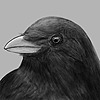HOME | DD
 Sorroxus — Arpagidon Kynigis
Sorroxus — Arpagidon Kynigis

#alien #aliencreature #aliendesign #alienplanet #biology #creature #creaturedesign #specbio #specevo #stithopod
Published: 2021-07-14 13:23:21 +0000 UTC; Views: 5513; Favourites: 27; Downloads: 0
Redirect to original
Description
Arpagidon Kynigis
scientific name: arpagidon kynigis
common name: arpagidon
average length: ~20-26 ft
average weight: ~1,000 lbs
The Arpagidon Kynigis (hunting grabbing-tooth) is a species of the genus arpagidonta, which is a genus of the family thalassadontidae. This family is part of the larger Theropterygia order, which is an order of completely aquatic formerly terrestrial stithopods that were descended from the leptognathids. The species lives off the southwestern coast of Concordia, and feeds upon medium-sized fish-like creatures.
The A. Kynigis is a relatively solitary creature, but is not highly territorial, but it prefers to feed and exist alone. However, the only time they are not solitary is during their mating season. Because the A. Kynigis, and by extension the whole Theropterygia order, descended from terrestrial forms, their spores are not adapted well to surviving the environment of the oceans and seas they inhabit. Because of this, their spores have not evolved to adapt to the ocean, but instead the whole order has evolved a type of reproduction not seen in terrestrial forms. When two A. Kynigis wish to mate, they will rub their trunks together, and the flesh around the pore that sperm comes out of has evolved small “lips,” which create an air-tight seal, and the passing of sperm from one individual to the other can occur without issue. When the spores of the impregnated have been fertilized, they will go through their growth process entirely inside the host. In essence, the fertilized host retains the spores until they turn into eggs, and even after the spores turn into eggs, they will still retain them. When the small clutch of eggs hatch, they hatch internally, and the babies are slid out of the pore which spores come out of in the terrestrial forms. By this point, the babies are well-developed enough to fend for themselves and feed themselves, and so the parent abandons them as soon as they emerge from their pore. This type of reproduction is unseen in all terrestrial stithopods, yet is pretty common in fully aquatic forms.
Diet for the A. Kynigis consists mainly of medium-sized fish forms, however they have also been observed to feed upon dead carcasses of much larger creatures, yet their most well adapted for catching, restraining and feeding on fish forms. Their long trunk is their best tool, and provides them with a great feeding envelope. The teeth lining the jaws at the end of their trunk are short yet sharp, and are made for catching and restraining prey as opposed to catching and tearing prey. The job of grinding up food is carried out by the gizzard (I’ve been using crop this entire time, and that’s wrong, sorry), where the food is sliced up and passed into the foregut and then the main gut.
However, despite being effective hunters of the oceans, the A. Kynigis is not immune to predation, and are often fed upon by the megalopterygians, which are the very largest of the fully aquatic stithopods, yet do not share the same order as the Arpagidons, and instead belong to an entirely different order, and are at the top of the oceanic food chain. But predation against the A. Kynigis is not often recorded, and the megalopterygians tend to feed on much larger filter feeding organisms.
sorry if the description was kind of bare and short, I was really tired and unmotivated at the time of writing this, but I’ll do a better description next time : /



















